Nineteen-Level Open Systems Interconnection Model
Good time to read, dear members habrahabr.ru
Not so long ago, I presented a nine-level model of open systems interaction ( http://habrahabr.ru/post/176391/ ).
This approach did not receive unequivocal support, and therefore the model had to be refined.
First - a quote, which, in my opinion, most fully reflects the direction of development.
')
J. Koplien, Multi-Paradigm Design for C ++. Library programmer. - SPb .: Peter, 2005. p. 99,
So, I offer the readers a seventeen-level model, which I propose to use when reading textbooks of philosophy, psychology, sociology, economics with the secret idea to translate all this into programming languages :-).
The approach is based on the philosophical idea of dualism, and begins with the introduction of two initial elements:
- ideas - as an abstraction, which is self-sufficient for its definition
- emptiness - as material, for which no idea is needed
The remaining elements are squeezed between these elements, symmetrically distancing them from each other as complexity develops. Qualitative levels of development of complexity and are presented in the underlying schemes /. The main assumption is the symmetry of the abstract and material - for material concepts there are symmetrical abstract ones. An additional assumption is a symmetrical disclosure of nature and concepts from the edges to the center.
For example, the extreme elements correspond to the most material (emptiness, for which additional characteristics are impossible) and the most abstract (an idea for which there is no material representation). This approach corresponds to the equal importance of the material and the ideal in the development of nature (dualism).
For all levels in the proposed model is the selection
The four elements of the Deming PDCA cycle: -Act-Plan-Do-Check-Act-
I note that the Hans Jürgen Eisenck coordinate system is selected from the three orthogonal axes as the basis:
- Psychoticism - level of abstractness
- Neuroticism and Extraversion - as a direction to the Deming cycle element in polar coordinates
Naturally, as the initial assumption, the schemes do not claim to be true. Everyone can create, using a spherical paradigm, their own variants, which will be based on their categories, levels, phases.
So, I represent the model - while in the form of graphic elements for modeling. At the heart of the left margin of the images remained a set of symbols, symmetrical with respect to reality.
General scheme:
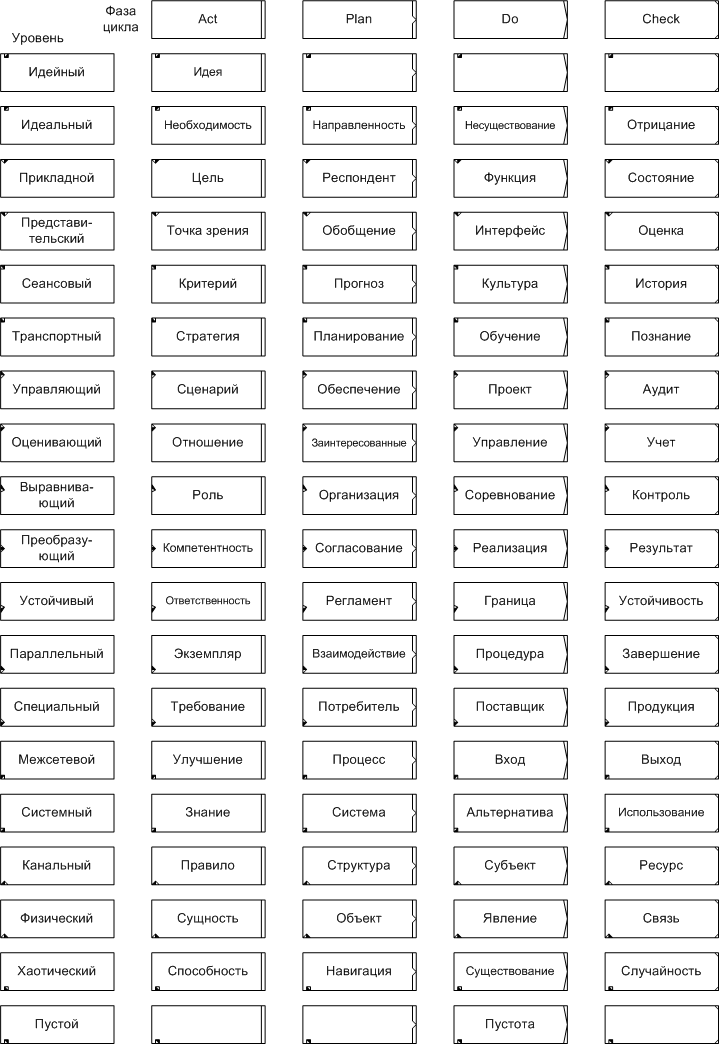
the order of the order of sciences in terms of abstractness:

As the most abstract concept, the idea stands out (Plato, Hume, Hegel)
The most appropriate idea is the negation , as an operation that is not applicable to more real elements. In this regard, the negation is often used to check the correctness. In mathematics, this is called "proof by contradiction."
The basis of the idea of something is not the existence of the idea itself. In addition, the idea of something is characterized by the purpose of the idea (indicated as directionality ).
In the value-normative component, an idea is characterized by necessity : any phenomenon can be expressed by its idea .
The least abstract, and the most material (bearing no idea ) is represented by the concept of emptiness (in C this is described by the type void ).
Moreover, even emptiness can be expressed with the idea of emptiness .
Following the empty level with increasing abstractness is the level of chaos.
Properties of matter at this level can only be described statistically. However, this statistic allows us to evaluate the field properties ( ability ) and determine the space-time characteristics for conglomerates - bodies. The main property of chaos is the existence of its elements. At the same time it is not possible to identify specific elements of the element trajectories ( randomness ).
Random level is the most fundamental. For example, it is difficult to foresee the emergence of comets from deep space, and Siberia, as the largest part of the land, is the most likely territory for meteors to fall.
In cybernetics, to protect against the influence of accidents, self-testing is used when the processor is turned on, as well as fool protection — an attempt to envisage a reaction to all possible user actions - logical (coinciding with the system's purpose) and not logical (by dropping a hedgehog on the keyboard)

For the ideal, the following segments are highlighted:
Purpose - as an attempt to determine the reason for the need to form a specific idea
Source of external justification of the goal ( respondent )
The possibilities of using ideas - a function
Method of fixing the achievement of the goal - the state
In material terms, they correspond to the behavior of matter, studied by physics - the interaction of two bodies or the interaction of body and field:
the first thing is to determine the type of interaction - the essence
the region of space-time is distinguished, whose behavior is estimated and predicted ( object )
for a selected object , its state ( phenomenon ) is fixed in a certain coordinate system
it turns out the environmental impact on the object
At the same time, for a specific study:
essence is fixed as the purpose of existence
the source of the purpose of justifying consideration is the object
the phenomenon of an object is assumed as its main function
possible states of an object are assumed to be mediated by its relations with the environment
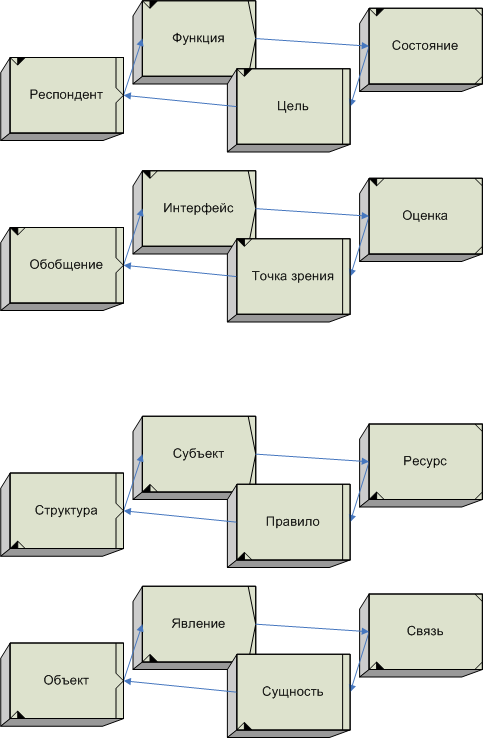
With the empowerment of the researcher, descriptions describing the structure of the studied concepts are added to the categories of existence and purpose.
In the area of the ideal:
A point of view is added, as a characteristic that unites a view of the world, representing a striving towards a goal
Generalization is singled out as a method of compressing several ideas into one when viewed from a specific perspective (to interact with a specific type of respondent , the actual abstraction )
An interface in this context means a designated set of ideas of transmitted and received signals , characterizing the designated function.
Assessment is defined as a procedure that helps to obtain information about the state of the external respondent.
Historically, this part is close to the work of shamans who broadcast the "will of the gods"
In the field of material, structural division appears, which corresponds to the identification of the structure of a substance (chemistry), information and the basis for the operations of logic and arithmetic, which are determined by the set of allowed rules
An entity identified at the previous level determines the applicability of rule sets
The selected object is analyzed for the possibility of determining its internal structure ( structure )
A phenomenon generates a subject that it modifies , as a sensor-receptor, aimed at fixing exactly this kind of phenomena.
The accumulation of previous changes of the subject characterizes the resource , the “caretaker” of which is considered the subject . The basis of the resource is supposed to be the connection of the phenomenon and the subject
The relationship between the ideal and the material for this pair of levels is determined by the following characteristics:
The point of view determines the set of rules used (is it possible to add red apples with green ones?)
The possibility of determining the structure is governed by the possibility of generalization (is it possible to combine hydrogen atoms with one concept when considering the properties of a water molecule)
The subject is characterized by the interface used (the scale does not determine the size or color of the object)
The accumulation of a certain resource requires the possibility of its assessment (for example, “not one” already requires the specification of the structure within which the assessment is made , the states of “little”, “enough”, “too much”, etc., are similarly evaluated)
Within these levels, the rules of logic and arithmetic are introduced.
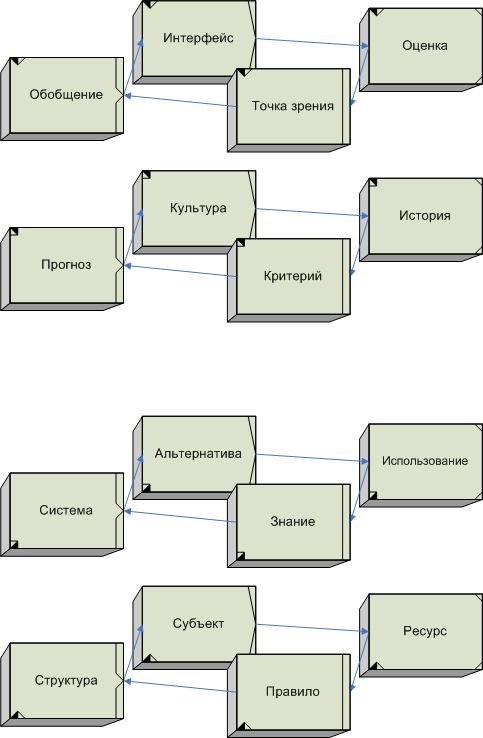
With further development, it becomes possible to use resources to maintain self-preservation.
In the area of the ideal, it becomes possible to predict future conditions based on known rules and a selected point of view.
A brief characteristic of the dynamic assessment of the situation are the criteria
In order to be able to continue to exist without deterioration of the state , the forecast of changes is used with possible options for changing the system and the environment.
The set of preferred actions determines the culture .
The ideal analogue of the resource appears - history , as a set of consequences of applying the rules along with the conditions of their use and results.
In the area of the material, there is an evolution of systems that provide their own homeostasis within an individual or species. This corresponds to the development of living beings and similar artificial formations.
Knowledge represents a set of rules with the context of their application in the presence of various ways of their own change.
The system in this case is understood in accordance with the following definition: system - a structure capable of maintaining homeostasis
For existence, the system may have a choice of several alternatives - ways of using resources.
After being used to implement one of the alternative possibilities, the available resources are quantitatively changed.
The relationship between the ideal and the material:
The knowledge accumulated by the system allows you to select the criteria that contribute to the preservation of the system
The maintenance of homeostasis itself requires the possibility of comparing predictions of actions for selected criteria.
Knowledge allows you to view several alternative actions ( choices ), and a set of priority alternatives ( culture ) appears.
When performing an action, accumulated resources are used . Evolution allows you to accumulate a history of situations, rules applied, and selected alternatives . Such an approach creates prerequisites for the development of science on the scale of a single cultural phenomenon - civilization.

After the emergence of systems sufficient for independent existence using environmental resources and the ability to memorize previous changes in an abstract form, there is the possibility of accumulating behavioral stereotypes, and, accordingly, learning opportunities.
In the realm of the ideal, the possibility of cognition arises, based on accumulated history , and the planning of behavior in accordance with the evaluation of the values of the criteria .
For the successful existence of a variety of different types of behavior strategy is applied. For example, eat grass and fear, or be a predator, and catch.
After choosing a strategy , it is possible to plan your behavior. For example, a cheetah tries to catch prey, and wolves organize a hunt in a group.
In the process of achieving (or not achieving) the goal , learning occurs - training endurance or increasing the number.
The result of learning is cognition , which contributes to the selection of criteria and improve strategies .
In the field of material psychological processes appear, which are described in the framework of the process approach.
In order to win in natural selection, the natural requirement is to improve the characteristics of the system .
To implement the behavior, it is possible to use various processes that represent ways to convert the input to the output . In accordance with the successful SADT (IDEF0) methodology, the required type of input is the manager - the starting process .
The process input must obtain the necessary resources for use, which the system must take care of. If the required input is not filled in, the process may stop. Sometimes this termination of the process leads to a catastrophe (lack of air at the diver or lack of regulation at the Chernobyl NPP).
The results of the execution process are “caught” at the output . If the output does not meet expectations, then this is a reason for improvement .
The relationship between the ideal and the material:
To improve the functioning of the system , a strategy is applied.
When choosing a process , planning is applied.
The supply of control signals to the input of the system facilitates the learning of possible behaviors.
Cognition tracks the system's output to expectations.
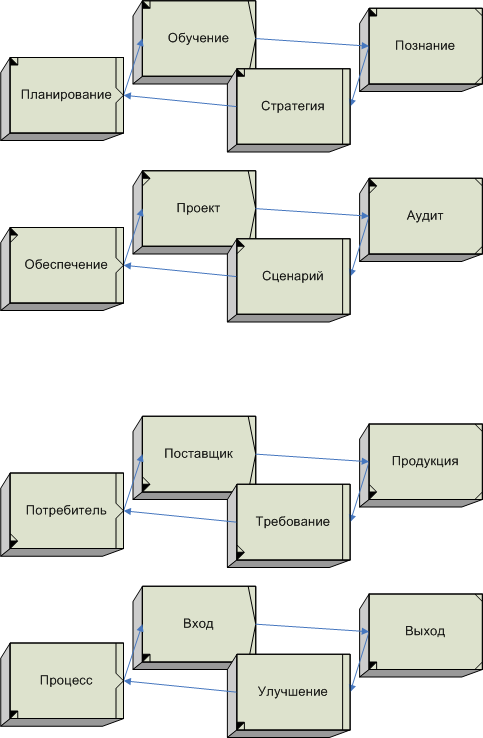
The result of training in the presence of different systems (and nature does not tolerate not only emptiness, but also sameness) is the possibility of comparing the propensity to perform the necessary or possible roles
In the field of the ideal, the possibility of cybernetic control appears.
implementation of the developed strategy contributes to the choice of the scenario , which will lead to an improvement in the value of the selected criterion
planning includes the need to ensure that the scenario is executed under specific conditions by transmitting a sequence of signals and material flows
Learning to perform the script is formulated in the form of a project - an ideal model of actions to be performed.
after the project is completed, an audit is performed - knowledge of the compliance of the built technological chain of the chosen strategy
In the field of material social relationships appear, based on the use of differences between material objects.
requirements contribute to the formulation of the desire to improve the subsystem in a material form
the consumer acts as the initiator of the launch of known processes
the supplier performs the task of inputting the process of the necessary control signals and resources obtained at the output of other processes
the significant output of the main executable process is the product , which can be evaluated for compliance with the requirements
The relationship between the ideal and the material:
Requirements for performing a role in society are accompanied by possible scenarios leading to the successful performance of this role.
the fulfillment of the social role is carried out to achieve customer satisfaction with this service; customer satisfaction serves to shape the need to ensure the necessary performance results from other members of the society
to meet the needs of the consumer, a member of society acts as a supplier of this service / product , while the product itself at this stage acts as a project
the result of the project is a product that is evaluated by the consumer using an audit - comparing the project and the product according to significant criteria

The next stage in the development of the social is the emergence of interchangeability (development of the army with the advent of types of troops, the opening of collective training, the appearance of workshops in medieval Europe, the allocation of merchants, the emergence of the proletariat)
In the field of the ideal, the opportunity arises for the exchange of products of labor and the appearance of trade with the release of a universal commodity equivalent — money.
the existence of relations between representatives of social groups corresponds to the subconscious
division of labor contributes to the search for those interested in applying their activities and ensuring the maintenance of livelihoods
Stakeholder interaction requires ongoing management to match developed projects.
considerations of equity require consideration , which serves to assess the correctness of the relationship
In the field of material appear economic relationships based on the ability to manage organizational structures .
the basis of the relationship is an organizational copy that is able to fulfill social requirements
the interaction proposal is a contract on the basis of which participants assume the future
elements of the implementation of the contract is a set of procedures that allow to evaluate the correctness of the actions performed
the need for the completion phase is dictated by the volatility of the relationship , this is especially evident in the change of brands of mobile phones :-)
The relationship between the ideal and the material:
relationships between elements to facilitate interaction at this level require a single instance representing the group
interaction of social groups requires mutual interest of groups in each other
interaction management takes place through agreed procedures
accounting in a continuous process leads to the need to designate completion points at which an essentially continuous process is assessed (financial year, session, elections)
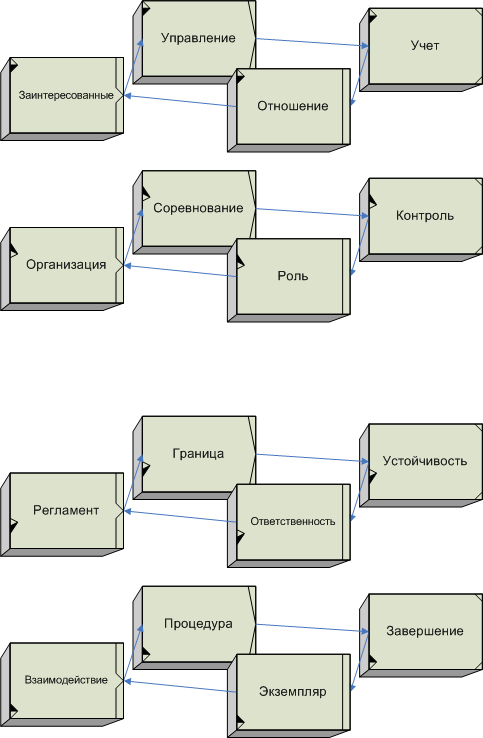
The next stage is the development of competition based on the rules of the same initial conditions, and thereby expanding the possibility of hierarchical methods of control for all civilization, the development of previously inaccessible territories (space, ocean) and understanding of humanity’s involvement in global processes of the Earth, Solar System, Universe
Are areas of responsibility that contribute to the development of the noosphere
In the area of the ideal:
many situations that arise in society gives rise to many necessary roles
for the appointment of a performer serves the organization
the possibility of choosing from a multitude of applicants contributes to the development of competition in capitalist society as such competition is used free competition of Adam Smith, in the classless - socialist competition of VI Ulyanov, in sports - championships and Olympic Games
to assess the correctness of the role is monitored
In the field of material:
to self-limit the impact of the potentially infinite expansion of resource consumption, responsibility arises for using technical and organizational capabilities
develops regulations for the implementation of activities that streamline the responsibility
limits of applicability of regulations in time and space are assigned
the main control parameter is assigned to the stability of the existence of a certain area of space / time
The discovery of this level corresponds to the publications of KE Tsiolkovsky, as well as science fiction writers of the 20th century.
The relationship between the material and the ideal:
role is assigned to assign responsibility for any area
regulations contribute to the organization of a part of society
competition between organizational elements requires the definition of boundaries between these elements (for example, antitrust laws)
The stability of a part of the space with respect to regulations and organization requires control over the effect of inaction / inaction on these organizations
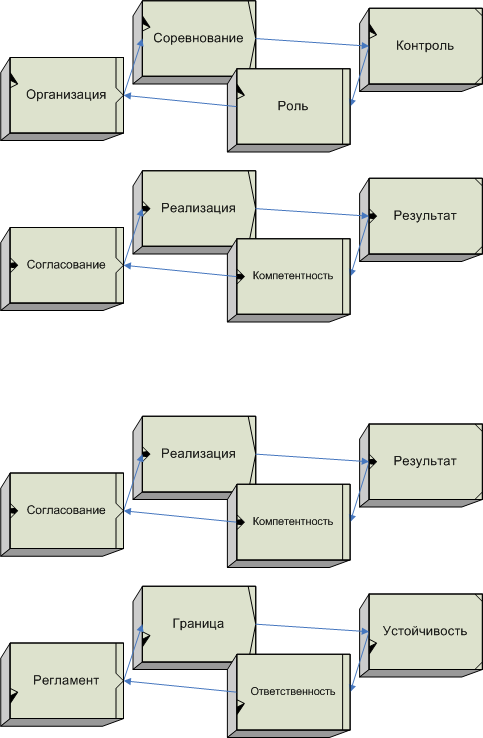
Competence is used to assess the compliance of responsibility for the performance of a role (education, certification, certification, licensing, etc. are applied)
for compliance of decisions of the organization to regulations the coordination mechanism serves
implementation is carried out within certain limits , in this case a public (competition, money) or non-public (glory, image, awards) competition is made
the result is the need of a competitive mechanism, while a stable (linear) change in the result is a sign of sustainability , and for the supervision of uniform use of resources , independent control is exercised
I hope this set of elements is enough to simulate most applications.
I would be grateful for a reason to change my mind in the form of criticism and wishes.
Upd 03/03/2014 - Added description text from integral-community.ru/forum/viewtopic.php?f=12&t=167
Upd: 04/30/2014 - a new version of the scheme

Upd: Previous version of 07/15/2014:

Upd 07/26/2014 - the number of levels is increased to 21, the Do phase is synchronized with the EPC:
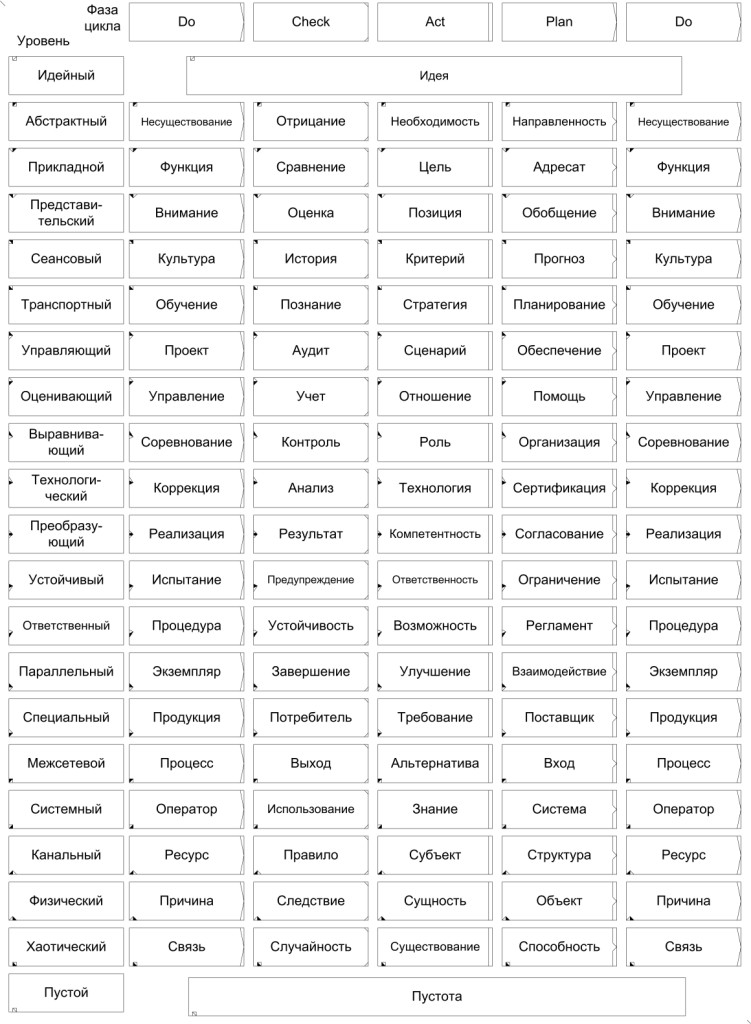
EPC versus tunnel simulation:

Not so long ago, I presented a nine-level model of open systems interaction ( http://habrahabr.ru/post/176391/ ).
This approach did not receive unequivocal support, and therefore the model had to be refined.
First - a quote, which, in my opinion, most fully reflects the direction of development.
')
J. Koplien, Multi-Paradigm Design for C ++. Library programmer. - SPb .: Peter, 2005. p. 99,
5.1 About paradigms and objects
The term “paradigm”, which became known from the book by Kahn [Kuhn, 1970], entered the everyday life of software in connection with the popularization of the object paradigm. A paradigm is a set of agreements in which we represent the world around us. In software, paradigms define how we formulate abstractions. What is your world made of? Do you divide the world into procedures? Data records? Modules? Or classes and objects?
In practice, the paradigm defines the rules, means and agreements for dividing the world into separate understandable parts. Paradigm objectives usually include a quality characteristic, roughly called modularity, which means that the analysis should create coherent abstractions with minimal cohesion. If abstractions are independent, then their owners can develop them separately, without interfering with each other. If we assume that the system can be developed in parts, then paradigms help us create islands of change.
So, I offer the readers a seventeen-level model, which I propose to use when reading textbooks of philosophy, psychology, sociology, economics with the secret idea to translate all this into programming languages :-).
The approach is based on the philosophical idea of dualism, and begins with the introduction of two initial elements:
- ideas - as an abstraction, which is self-sufficient for its definition
- emptiness - as material, for which no idea is needed
The remaining elements are squeezed between these elements, symmetrically distancing them from each other as complexity develops. Qualitative levels of development of complexity and are presented in the underlying schemes /. The main assumption is the symmetry of the abstract and material - for material concepts there are symmetrical abstract ones. An additional assumption is a symmetrical disclosure of nature and concepts from the edges to the center.
For example, the extreme elements correspond to the most material (emptiness, for which additional characteristics are impossible) and the most abstract (an idea for which there is no material representation). This approach corresponds to the equal importance of the material and the ideal in the development of nature (dualism).
For all levels in the proposed model is the selection
The four elements of the Deming PDCA cycle: -Act-Plan-Do-Check-Act-
I note that the Hans Jürgen Eisenck coordinate system is selected from the three orthogonal axes as the basis:
- Psychoticism - level of abstractness
- Neuroticism and Extraversion - as a direction to the Deming cycle element in polar coordinates
Naturally, as the initial assumption, the schemes do not claim to be true. Everyone can create, using a spherical paradigm, their own variants, which will be based on their categories, levels, phases.
So, I represent the model - while in the form of graphic elements for modeling. At the heart of the left margin of the images remained a set of symbols, symmetrical with respect to reality.
General scheme:

the order of the order of sciences in terms of abstractness:
logical
religious
philosophical
cultural
political
management
marketing
sports
technological
transformative
steady
synergistic
economic
social
psychological
biological
chemical
physical
astrophysical
Perfect and tangible

As the most abstract concept, the idea stands out (Plato, Hume, Hegel)
The most appropriate idea is the negation , as an operation that is not applicable to more real elements. In this regard, the negation is often used to check the correctness. In mathematics, this is called "proof by contradiction."
The basis of the idea of something is not the existence of the idea itself. In addition, the idea of something is characterized by the purpose of the idea (indicated as directionality ).
In the value-normative component, an idea is characterized by necessity : any phenomenon can be expressed by its idea .
The least abstract, and the most material (bearing no idea ) is represented by the concept of emptiness (in C this is described by the type void ).
Moreover, even emptiness can be expressed with the idea of emptiness .
Following the empty level with increasing abstractness is the level of chaos.
Properties of matter at this level can only be described statistically. However, this statistic allows us to evaluate the field properties ( ability ) and determine the space-time characteristics for conglomerates - bodies. The main property of chaos is the existence of its elements. At the same time it is not possible to identify specific elements of the element trajectories ( randomness ).
Random level is the most fundamental. For example, it is difficult to foresee the emergence of comets from deep space, and Siberia, as the largest part of the land, is the most likely territory for meteors to fall.
In cybernetics, to protect against the influence of accidents, self-testing is used when the processor is turned on, as well as fool protection — an attempt to envisage a reaction to all possible user actions - logical (coinciding with the system's purpose) and not logical (by dropping a hedgehog on the keyboard)
Physical and Religious

For the ideal, the following segments are highlighted:
Purpose - as an attempt to determine the reason for the need to form a specific idea
Source of external justification of the goal ( respondent )
The possibilities of using ideas - a function
Method of fixing the achievement of the goal - the state
In material terms, they correspond to the behavior of matter, studied by physics - the interaction of two bodies or the interaction of body and field:
the first thing is to determine the type of interaction - the essence
the region of space-time is distinguished, whose behavior is estimated and predicted ( object )
for a selected object , its state ( phenomenon ) is fixed in a certain coordinate system
it turns out the environmental impact on the object
At the same time, for a specific study:
essence is fixed as the purpose of existence
the source of the purpose of justifying consideration is the object
the phenomenon of an object is assumed as its main function
possible states of an object are assumed to be mediated by its relations with the environment
Chemical and Philosophical

With the empowerment of the researcher, descriptions describing the structure of the studied concepts are added to the categories of existence and purpose.
In the area of the ideal:
A point of view is added, as a characteristic that unites a view of the world, representing a striving towards a goal
Generalization is singled out as a method of compressing several ideas into one when viewed from a specific perspective (to interact with a specific type of respondent , the actual abstraction )
An interface in this context means a designated set of ideas of transmitted and received signals , characterizing the designated function.
Assessment is defined as a procedure that helps to obtain information about the state of the external respondent.
Historically, this part is close to the work of shamans who broadcast the "will of the gods"
In the field of material, structural division appears, which corresponds to the identification of the structure of a substance (chemistry), information and the basis for the operations of logic and arithmetic, which are determined by the set of allowed rules
An entity identified at the previous level determines the applicability of rule sets
The selected object is analyzed for the possibility of determining its internal structure ( structure )
A phenomenon generates a subject that it modifies , as a sensor-receptor, aimed at fixing exactly this kind of phenomena.
The accumulation of previous changes of the subject characterizes the resource , the “caretaker” of which is considered the subject . The basis of the resource is supposed to be the connection of the phenomenon and the subject
The relationship between the ideal and the material for this pair of levels is determined by the following characteristics:
The point of view determines the set of rules used (is it possible to add red apples with green ones?)
The possibility of determining the structure is governed by the possibility of generalization (is it possible to combine hydrogen atoms with one concept when considering the properties of a water molecule)
The subject is characterized by the interface used (the scale does not determine the size or color of the object)
The accumulation of a certain resource requires the possibility of its assessment (for example, “not one” already requires the specification of the structure within which the assessment is made , the states of “little”, “enough”, “too much”, etc., are similarly evaluated)
Within these levels, the rules of logic and arithmetic are introduced.
Biological and Scientific

With further development, it becomes possible to use resources to maintain self-preservation.
In the area of the ideal, it becomes possible to predict future conditions based on known rules and a selected point of view.
A brief characteristic of the dynamic assessment of the situation are the criteria
In order to be able to continue to exist without deterioration of the state , the forecast of changes is used with possible options for changing the system and the environment.
The set of preferred actions determines the culture .
The ideal analogue of the resource appears - history , as a set of consequences of applying the rules along with the conditions of their use and results.
In the area of the material, there is an evolution of systems that provide their own homeostasis within an individual or species. This corresponds to the development of living beings and similar artificial formations.
Knowledge represents a set of rules with the context of their application in the presence of various ways of their own change.
The system in this case is understood in accordance with the following definition: system - a structure capable of maintaining homeostasis
For existence, the system may have a choice of several alternatives - ways of using resources.
After being used to implement one of the alternative possibilities, the available resources are quantitatively changed.
The relationship between the ideal and the material:
The knowledge accumulated by the system allows you to select the criteria that contribute to the preservation of the system
The maintenance of homeostasis itself requires the possibility of comparing predictions of actions for selected criteria.
Knowledge allows you to view several alternative actions ( choices ), and a set of priority alternatives ( culture ) appears.
When performing an action, accumulated resources are used . Evolution allows you to accumulate a history of situations, rules applied, and selected alternatives . Such an approach creates prerequisites for the development of science on the scale of a single cultural phenomenon - civilization.
Psychological and Political

After the emergence of systems sufficient for independent existence using environmental resources and the ability to memorize previous changes in an abstract form, there is the possibility of accumulating behavioral stereotypes, and, accordingly, learning opportunities.
In the realm of the ideal, the possibility of cognition arises, based on accumulated history , and the planning of behavior in accordance with the evaluation of the values of the criteria .
For the successful existence of a variety of different types of behavior strategy is applied. For example, eat grass and fear, or be a predator, and catch.
After choosing a strategy , it is possible to plan your behavior. For example, a cheetah tries to catch prey, and wolves organize a hunt in a group.
In the process of achieving (or not achieving) the goal , learning occurs - training endurance or increasing the number.
The result of learning is cognition , which contributes to the selection of criteria and improve strategies .
In the field of material psychological processes appear, which are described in the framework of the process approach.
In order to win in natural selection, the natural requirement is to improve the characteristics of the system .
To implement the behavior, it is possible to use various processes that represent ways to convert the input to the output . In accordance with the successful SADT (IDEF0) methodology, the required type of input is the manager - the starting process .
The process input must obtain the necessary resources for use, which the system must take care of. If the required input is not filled in, the process may stop. Sometimes this termination of the process leads to a catastrophe (lack of air at the diver or lack of regulation at the Chernobyl NPP).
The results of the execution process are “caught” at the output . If the output does not meet expectations, then this is a reason for improvement .
The relationship between the ideal and the material:
To improve the functioning of the system , a strategy is applied.
When choosing a process , planning is applied.
The supply of control signals to the input of the system facilitates the learning of possible behaviors.
Cognition tracks the system's output to expectations.
Managerial and Social

The result of training in the presence of different systems (and nature does not tolerate not only emptiness, but also sameness) is the possibility of comparing the propensity to perform the necessary or possible roles
In the field of the ideal, the possibility of cybernetic control appears.
implementation of the developed strategy contributes to the choice of the scenario , which will lead to an improvement in the value of the selected criterion
planning includes the need to ensure that the scenario is executed under specific conditions by transmitting a sequence of signals and material flows
Learning to perform the script is formulated in the form of a project - an ideal model of actions to be performed.
after the project is completed, an audit is performed - knowledge of the compliance of the built technological chain of the chosen strategy
In the field of material social relationships appear, based on the use of differences between material objects.
requirements contribute to the formulation of the desire to improve the subsystem in a material form
the consumer acts as the initiator of the launch of known processes
the supplier performs the task of inputting the process of the necessary control signals and resources obtained at the output of other processes
the significant output of the main executable process is the product , which can be evaluated for compliance with the requirements
The relationship between the ideal and the material:
Requirements for performing a role in society are accompanied by possible scenarios leading to the successful performance of this role.
the fulfillment of the social role is carried out to achieve customer satisfaction with this service; customer satisfaction serves to shape the need to ensure the necessary performance results from other members of the society
to meet the needs of the consumer, a member of society acts as a supplier of this service / product , while the product itself at this stage acts as a project
the result of the project is a product that is evaluated by the consumer using an audit - comparing the project and the product according to significant criteria
Marketing and utilities

The next stage in the development of the social is the emergence of interchangeability (development of the army with the advent of types of troops, the opening of collective training, the appearance of workshops in medieval Europe, the allocation of merchants, the emergence of the proletariat)
In the field of the ideal, the opportunity arises for the exchange of products of labor and the appearance of trade with the release of a universal commodity equivalent — money.
the existence of relations between representatives of social groups corresponds to the subconscious
division of labor contributes to the search for those interested in applying their activities and ensuring the maintenance of livelihoods
Stakeholder interaction requires ongoing management to match developed projects.
considerations of equity require consideration , which serves to assess the correctness of the relationship
In the field of material appear economic relationships based on the ability to manage organizational structures .
the basis of the relationship is an organizational copy that is able to fulfill social requirements
the interaction proposal is a contract on the basis of which participants assume the future
elements of the implementation of the contract is a set of procedures that allow to evaluate the correctness of the actions performed
the need for the completion phase is dictated by the volatility of the relationship , this is especially evident in the change of brands of mobile phones :-)
The relationship between the ideal and the material:
relationships between elements to facilitate interaction at this level require a single instance representing the group
interaction of social groups requires mutual interest of groups in each other
interaction management takes place through agreed procedures
accounting in a continuous process leads to the need to designate completion points at which an essentially continuous process is assessed (financial year, session, elections)
Competitive and Cosmic

The next stage is the development of competition based on the rules of the same initial conditions, and thereby expanding the possibility of hierarchical methods of control for all civilization, the development of previously inaccessible territories (space, ocean) and understanding of humanity’s involvement in global processes of the Earth, Solar System, Universe
Are areas of responsibility that contribute to the development of the noosphere
In the area of the ideal:
many situations that arise in society gives rise to many necessary roles
for the appointment of a performer serves the organization
the possibility of choosing from a multitude of applicants contributes to the development of competition in capitalist society as such competition is used free competition of Adam Smith, in the classless - socialist competition of VI Ulyanov, in sports - championships and Olympic Games
to assess the correctness of the role is monitored
In the field of material:
to self-limit the impact of the potentially infinite expansion of resource consumption, responsibility arises for using technical and organizational capabilities
develops regulations for the implementation of activities that streamline the responsibility
limits of applicability of regulations in time and space are assigned
the main control parameter is assigned to the stability of the existence of a certain area of space / time
The discovery of this level corresponds to the publications of KE Tsiolkovsky, as well as science fiction writers of the 20th century.
The relationship between the material and the ideal:
role is assigned to assign responsibility for any area
regulations contribute to the organization of a part of society
competition between organizational elements requires the definition of boundaries between these elements (for example, antitrust laws)
The stability of a part of the space with respect to regulations and organization requires control over the effect of inaction / inaction on these organizations
Changeable

Competence is used to assess the compliance of responsibility for the performance of a role (education, certification, certification, licensing, etc. are applied)
for compliance of decisions of the organization to regulations the coordination mechanism serves
implementation is carried out within certain limits , in this case a public (competition, money) or non-public (glory, image, awards) competition is made
the result is the need of a competitive mechanism, while a stable (linear) change in the result is a sign of sustainability , and for the supervision of uniform use of resources , independent control is exercised
I hope this set of elements is enough to simulate most applications.
I would be grateful for a reason to change my mind in the form of criticism and wishes.
Upd 03/03/2014 - Added description text from integral-community.ru/forum/viewtopic.php?f=12&t=167
Upd: 04/30/2014 - a new version of the scheme

Upd: Previous version of 07/15/2014:

Upd 07/26/2014 - the number of levels is increased to 21, the Do phase is synchronized with the EPC:

EPC versus tunnel simulation:

Source: https://habr.com/ru/post/203770/
All Articles